What Is The Money Pit On Oak Island
The Oak Island curse says seven men must die before the island reveals its legendary treasure. Six have perished in the search for billions in gold, but the danger has only fueled exploration and speculation.
"Frustrating, fascinating, enticing—you put any adjective you want in front of Oak Island and that's what it is," says Charles Barkhouse, historian for the History Channel show The Curse of Oak Island, which has chronicled an ongoing search for the treasure for eight seasons (with few results). "If you're not prepared for the emotional ride, you can pack up your toys and go." Hunts for the Oak Island Money Pit, a 100-foot hole on an island in Nova Scotia, allegedly containing anything from pirate treasure to the Ark of the Covenant, date back to 1795. While no treasure has been found, peripheral discoveries—apparent clues, possible traps, and geological curiosities—have compelled searchers onward, even as historians dispute the more sensational claims surrounding the treasure. Was Oak Island a trove for the Knights Templar, a secret British industrial center, or an ill-fated natural sinkhole? The answer, of course, takes some digging.

.
The Search Begins
Oak Island first garnered intrigue soon after the "Golden Age of Piracy" (roughly 1650–1730), when Edward Low and Bartholo mew Roberts patrolled the seas northeast of the Americas. In 1795, a Nova Scotia teenager reportedly saw strange lights hovering over the island from his home on the mainland. He heralded two friends and rowed over to investigate. In a copse of trees on the southeastern side of the island, the boys found a 13-foot-wide depression surrounded by loose soil and young trees—signs the ground had been disturbed.
The boys began to dig out what would be known as the Money Pit. Two feet down, they found a circle of stones bordering the circumference of the pit, and at 10 feet, they found a platform of cut timbers fit into the sides of the pit. A second platform lay 20 feet down, but that's where the account of the first search ends. The story resumes in the early 1800s, when the Onslow Company embarked on the first official expedition to excavate the discovery. They picked up where the first dig left off, finding more platforms every 10 feet, sometimes with layers of putty, charcoal, or coconut fibers on top. Coconuts don't grow within 900 miles of Nova Scotia, but the story alleges the crew made a more monumental discovery at 90 feet: a rectangular stone inscribed with strange markings.

Nova Scotia Archives
Researchers and treasure hunters dismissed the markings as being made by the excavator's tools by mistake, but others were certain they were a secret code leading to buried treasure. In the 1860s, a professor of languages from Nova Scotia's Dalhousie University examined the stone and determined the code was a substitution cipher saying: "Forty Feet Below Two Million Pounds Are Buried." But another attempted translation in the 1970s interpreted the code as a Coptic Christian warning not to forget your duty to the Lord.
The Onslow Company kept digging, and at 98 feet they hit what sounded like a hollow container—assumed to be a treasure vault. The crew stopped work for the evening, but when they returned the next morning, they found the pit filled with 60 feet of water. It was thought their digging had triggered a booby trap. The flooding seems to have ended Onslow's efforts; the company dissolved in 1805.

.
The Curse Strikes
Another expedition to Oak Island launched from the nearby town of Truro in 1849. That crew was reportedly able to bail out the water in the pit and reinforce its walls before drilling into the "vault." The drill penetrated successive layers of wood and loose metal, suggesting a treasure chest, and according to a newspaper account published years later, surfaced three small links of gold chain. But before the crew could access the vault, the bottom of the Money Pit collapsed and flooded again, taking the presumed treasure with it.
Undeterred, the crew believed they had found a flood tunnel that channeled water to the pit from the man-made Smith's Cove approximately 500 feet east of the dig site. Digging at Smith's Cove revealed five rock-lined sluices extending away from the beach and coalescing into a single drain that appeared to lead to the Money Pit. The Truro group dug shafts to intercept this drain, with no success. Around this time, the first reports of the Oak Island curse appear. The origins of the curse are muddled—the decades between the search's beginning and the curse's first mention confuse the story—but the first recorded fatality tied to the Oak Island treasure is dated to the early 1860s, when a steam-powered pump used to drain the Money Pit exploded, killing one man.
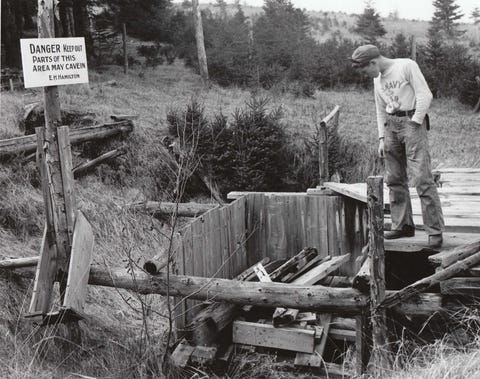
Nova Scotia Archives
As news of the dangerous, dramatic hunt spread, Oak Island attracted more excursions, which opened more pits, but these only obfuscated the truth of the treasure. Searchers in 1897 unearthed a tiny piece of parchment bearing what appears to be the letters "vi." Specialists at Harvard University confirmed the parchment's authenticity, though it's unclear whether that meant it was "authentically" a folio full of secrets or a scrap from earlier inhabitants of the island. 1897 is also notable for bringing about the second hunt-related death, when a man fell to his death. Four more fatalities, a result of noxious underground fumes, followed in 1965.
Modern technology hasn't delivered a breakthrough. A 1971 crew brought cameras and a monitor to explore their approximately 235-foot shaft (called Borehole 10X, about 180 feet from the Money Pit), and while they claimed the feed revealed a wooden chest and a severed human hand at the bottom of the pit, the incident was never recorded.
Today, the History Channel's Curse of Oak Island hosts Rick and Marty Lagina use seismic testing, ground-penetrating radar, drilling, and dye tests, says Barkhouse. "They're throwing every bit of science and technology they can at the island."
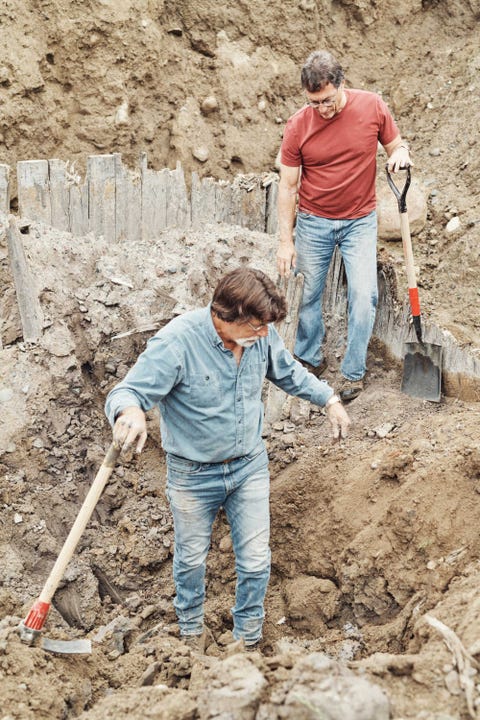
The History Channel
Among other clues, the show's crew has uncovered a lead iron cross they attribute to the Knights Templar, a bone fragment, and a buried, U-shaped wooden structure found beneath Smith's Cove. None of these discoveries have solved the mystery, but that might not be a point of urgency—the Lagina brothers own the majority of the tour company that operates on the island, plus a TV show promoting that island.
Even so, Barkhouse says, "the amount of evidence we're finding [on Oak Island] leads you to believe that some group or some person did something special there."

.
Holes In the Search
Oak Island is sometimes called "Hoax Island" for its lack of eyewitness evidence. There is no direct evidence that verifies any excavation on Oak Island before the early 1860s, when the first two expeditions by the Nova Scotia boys and the Onslow Company first appeared on record. Most other 19th-century accounts of Oak Island are "as told to" recollections by men claiming to be involved in the digs.
The gaps add up: Many believe the gold chain links from the 1849 group were planted by excavators to encourage future expeditions, and the inscribed stone found in the early 1800s wasn't recorded as found until 1862. The stone wasn't mentioned at all in the Oak Island Treasure Company's 1893 Investment Prospectus, and neither itself nor its markings were sketched or photographed. The rendering of the stone that exists today is dated to 1949; that's where modern translations originate. As for the curse and the deaths attached to it, Kristina Downs, Ph.D., the managing editor for the Journal of Folklore Research at Indiana University, urges treasure hunters to treat these events with skepticism. She points out that curses and cryptic ciphers are often manufactured in service of legitimizing unproven claims.
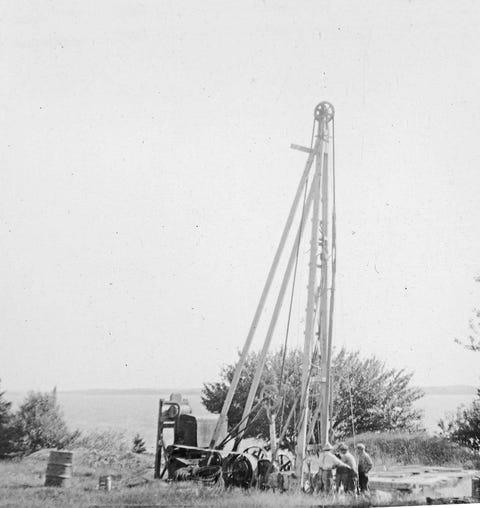
Nova Scotia Archives
"You could make an argument that there is a common structure to buried treasure [stories]," Downs says. "The treasure being lost somehow, the stories about it are told as true, and the fact that the treasure is never recovered…fall under the category of 'validating formulas,' which are added to a legend to help its credibility."
The curse is unsubstantiated, but its legend can still be leveraged to dissuade seekers, and for treasure hunters, that could mean the pit holds a secret worth protecting.

.
Tall Tales of the Money Pit
Speculation abounds over what exactly the Oak Island Money Pit is in the first place: a communal bank for pirates, a repository for treasure plundered by the British military, or a crude savings account to fund the American Revolution. One robust theory claims the pit was built by the Knights Templar, the precursor to the Freemasons. Researchers interpreted some etchings on the island, as well as a large and vaguely Masonic stone triangle, as evidence the island was a hiding place for religious artifacts like the Holy Grail and the Ark of the Covenant.
Downs says these theories are driven by the same mechanisms that propel belief in conspiracy theories. "Humans like to believe there is some kind of order to the world around us," she says. "The reality is, they don't always [see such order]. We often create narratives to make sense out of a world we have trouble understanding." Archaeological and geological counterevidence concerning Oak Island and the Money Pit point to something well short of an Indiana Jones movie. Pick handles, coins, and a hinge have been found in and around the Money Pit, but that's no surprise, given the number of expeditions and inhabitants proven to have taken place there. Money Pit researcher Dennis J. King writes the alleged flood tunnels from Smith's Cove are remnants of a sea salt harvesting operation unrelated to the Money Pit, and the coconut fiber found on the island was likely packing material on ships, a common practice of the time.
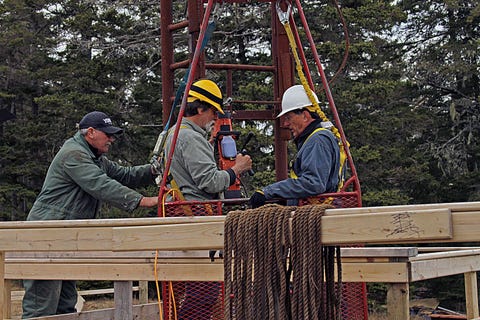
The History Channel
Nonetheless, the truth of Oak Island retains elements of intrigue. Research conducted by historian Joy A. Steele and retired marine geologist Gordon Fader demonstrates that Oak Island housed a covert British industrial center. The pair examined business records and contemporaneous correspondence to conclude that in 1720 the Crown chartered private companies together with the British military to do business on Oak Island—including pine tar works, brass making, and wire drawing—to help clear debt. It was the largest industrial development in Canada at the time, Fader says: "There were a million reasons to go to Oak Island—closest to fresh water, closest to shore, safe, good anchorage—it's the biggest island in the Bay."
Steele and Fader are certain the Money Pit was a natural geological feature on the island, one the Brits used as a pine tar kiln to produce tar and pitch for coating their ships. The excavated layers of the Money Pit—the wood, charcoal, and putty—align with what would be expected in an old tar kiln, Fader says. He points out that the U-shaped structure buried on Smith's Cove was likely part of a storage shed for keeping the pine tar in barrels and out of the sun.
"In those days, pine tar was of equal importance to oil today: Your ship didn't go to sea unless it was soaked in pine tar. That's what they were doing on the island. All the artifacts we see fit that theory exactly," Fader says.
The Chancellor of the Exchequer of England (essentially the Minister of Finance) and other high-ranking banking officials of the day often referred to "The Secret" in their correspondence, Steele says, which "is [surely] the Oak Island project."
"I am surprised historians never picked up on this and dared to find out what the 'secret' was," she says. "[Oak Island] carried out what would have been a very lucrative commodities scheme."

.
Natural Counter-evidence
A final argument against a man-made Money Pit is founded in the area's geological conditions. The island's bedrock is prone to dissolution by the sea and water table, Fader says. This creates a system of underground fractures and caves (a karst system) prone to collapse and the formation of sinkholes. Fader mapped the underground conditions along the coast of Nova Scotia while working as a marine geologist for the Canadian government, and says sinkholes are common in the area.
"The idea of pirates hewing out a treasure vault with pickaxes in bedrock is ridiculous."
"You can watch a sinkhole develop and a 60-foot pine tree fall down [into it] in two seconds," he says, illustrating how the pit could accommodate items as large as British ship masts. At least two sinkholes have been identified on Oak Island, and many more occur on the adjacent mainland. Steven Aitken, Ph.D., a geoscientist with over 25 years of experience studying the Oak Island area, says natural evidence points to the Money Pit itself being a sinkhole. In step with Fader's assertions, Aitken says the bedrock beneath that side of the island has locally dissolved, forming a karst system, and some of that system's caves have collapsed and formed sinkholes, including the Money Pit. "Sinkholes are like garbage cans of the geological world," Aitken says. "They're often filled with collapsed breccia [a type of sedimentary rock] overlain by a mixture of organic debris and sediment." Aitken writes that deposits above the breccia at the Money Pit are "overthickened up to 37 feet, indicating later infilling of a depression." The original depression discovered back in 1795 fits a typical surface expression of a sinkhole as well, Aitken says.
Flooding of the Money Pit, which the legend claims to be evidence of a booby trap, occurs naturally on that part of Oak Island due to the influx of fresh water from sands of the island's subsurface. "If shafts or wellbores are not packed back with impermeable clay or cased while drilling through sands above the bedrock, fresh water will naturally flood these excavations," Aitken explains.
"The idea of pirates hewing out a treasure vault with pickaxes in bedrock is ridiculous," Aitken says. "I don't want to diminish anyone's dream, but there is no treasure vault or booby trap designed to protect buried treasure at the Money Pit. All these features can be explained with basic science."
Charles Barkhouse doesn't feel that rational explanations and complex theories have to be mutually exclusive. He says if anything, the geological conditions of the island have deepened the mystery by sweeping the buried loot away underground, and the evidence collected onsite suggests the treasure is so impressive that many different groups have been involved with it over the centuries.
"No matter where you walk on that island, you're walking through history," Barkhouse says. "You can't take everything that's been found and pin it on one theory; that's what's so strange about this place. I will never stop believing there is a treasure buried on Oak Island and it's still there. I feel it."
The allure of real treasure, be it the Holy Grail, the Ark of Covenant, or a massive pirate bank, subsumes all other findings on Oak Island. The hunt might never end. The obsession of riches, as one recorded treasure seeker indicated back in 1862, could be worth the struggle.
"Should we be successful in getting a large amount of treasure we will be considered a very sensible lot of fellows," he wrote. "[A]nd if we should fail in finishing the work we will be set down as a set of phantom-following fools, fit for nothing but to be held up to public ridicule."

.
How Sinkholes Form
There are at least three observable sinkholes on Oak Island, and the area's geography suggests it is susceptible to these natural hazards. The island's subsurface is made up of soluble limestone anhydrite and gypsum rock, and the water table starts only a few meters below the surface, according to geologist Gordon Fader.

▲ Figure 1
On Oak Island, sinkholes form primarily through a process called dissolution. During dissolution, water permeates and erodes soluble minerals in the subsurface rock to create a Swiss cheese–like series of underground cracks, pathways, and chambers.
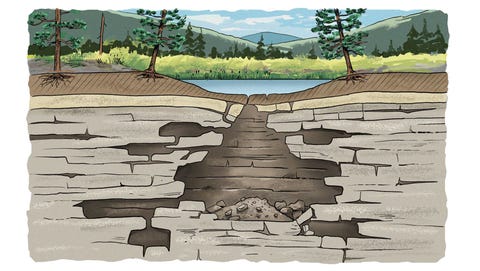
▲ Figure 2
These holes and cracks expand over time, propagating upward toward the topsoil.
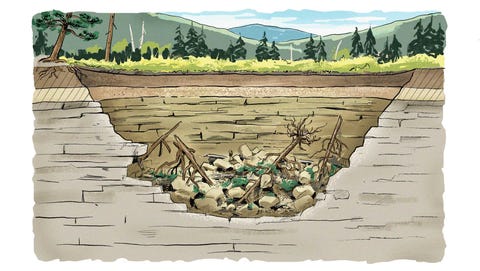
▲ Figure 3
Finally, when the weight of the topsoil is too much for the weakened subsurface soil to bear, the surface collapses. "It's the same as if in your house, someone cut out the posts that hold the walls up. The roof would collapse," Fader says.
Sinkholes can form over the course of decades, and collapse in a matter of seconds, depending on the geological conditions and overlying materials. Collapse can be expedited by a sudden influx of water into the subsurface, or by freezing and thawing. Fader says under the right circumstances, a sinkhole can be 130 to 165 feet across. He is adamant this phenomenon is the true origin of the Oak Island Money Pit.
This content is created and maintained by a third party, and imported onto this page to help users provide their email addresses. You may be able to find more information about this and similar content at piano.io
What Is The Money Pit On Oak Island
Source: https://www.popularmechanics.com/adventure/a36082822/the-real-story-of-the-oak-island-money-pit/
Posted by: feltonocuslike84.blogspot.com

0 Response to "What Is The Money Pit On Oak Island"
Post a Comment